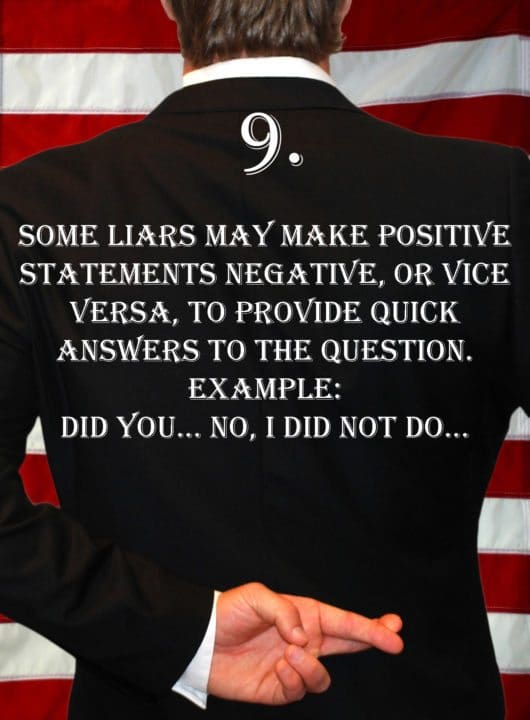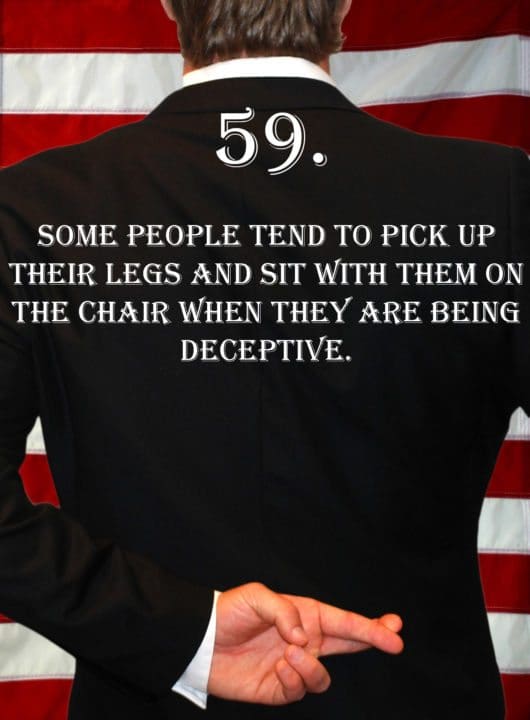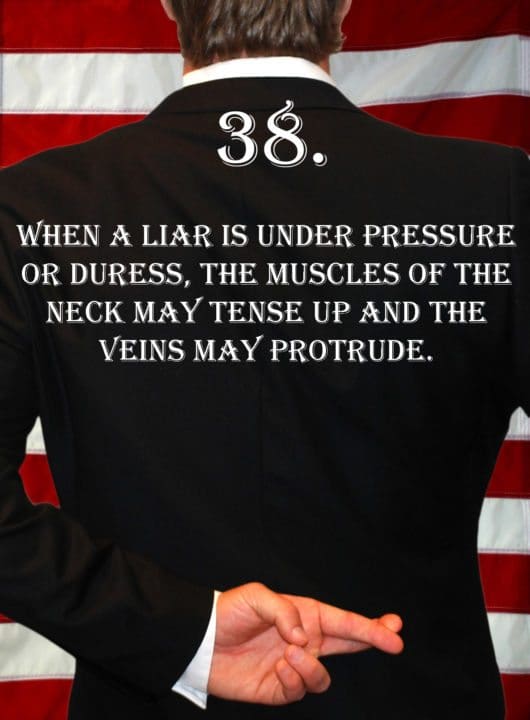
Deception Tip 9:
Some liars may make positive statements negative, or vice versa, to provide quick answers to the question.
Example: Did you… No, I did not do…
Listen To The Podcast!
E9 – Converting Statements – Deception Tips Podcast – Click Here To Subscribe
Podcast Transcript
Hello, and welcome to the Deception Tips Podcast, where you will learn amazing cues to detect deceit that will help you read people like never before. I’m your host, Spencer Coffman. Let’s get started.
Welcome to episode 9 of the Deception Tips Podcast. Last time, we talked about how liars will unconsciously place objects between themselves and the target, or questioner, whomever they are trying to fool.
These objects can be anything relating to their surroundings, whatever they have to work with. It can even be their body parts, as we discussed when we talked about covering sensitive areas of the body, such as placing the hands in the lap, folding their arms, etcetera.
Those types of behaviors are blocking people from seeing what’s going on. They’re covering up a vulnerability in their story. It’s unconscious behavior. They may not look or seem vulnerable but, in their mind, their unconscious believes they are vulnerable because they have just told a lie.
The conscious is feeling really confident like it can get that lie out with no problem, and the unconscious says, “No, no. I’m a truthful person. You told a lie. That makes me vulnerable. So, I’m going to leak this behavior of covering up the genital area or folding my arms.” Those types of behaviors are covering, and blocking. That’s a vulnerability move.
In addition, what we talked about last time, was adding objects to the equation. Such as putting a newspaper in your lap, a file folder, something maybe like clutching a binder or notebook.
You see women do that oftentimes where they kind of fold their arms and hold each corner of the notebook while holding it in, almost like they’re giving it a hug. That type of behavior is putting another object between themselves and whoever they are talking with or to, or whoever is asking them these questions.
In addition, you see this a lot with guys. Where they grab a chair, turn it around backward, sit in it, and kind of lean over the top of the chair, the back of the chair, with that chair back in between them and whomever they are talking with.
Kind of like a superiority move, or like something where they feel confident, or they’re cool by putting that there. But really, that is a vulnerability thing. It’s putting something between themselves and whomever they are talking to.
Now, obviously, you need to pay attention to at what point in conversations things like this happens. When do they reach for their binder, or their notebook, and put it in front of them? When do they stand up the book that they’re reading on the desk or something like that?
Because when that happens, now you know that something is happening where they are trying to add a barrier. They’re adding some personal security to their little comfort zone. They’re protecting their bubble.
This can even be seen in office interviews, conversations, discussions, things like that where one person sits on one side of the desk and another person sits on the other. Now, that is obviously a natural boundary so pay attention to things that are added.
Like I said if you grab a notebook and put it there, or another barrier, or something like that. Whenever boundaries are increased or added, that’s when the sign of deception is starting to be apparent. And, of course, look for additional signs.
For example, if they put whatever it is, in front of a sensitive area now that is a double sign of deception in which case, it becomes a cluster or pattern of behavior. That gives you more of a reason to suspect them of being deceptive. Today we are going to talk about another sign of deception.
Of course, this one, instead of a bodily movement or body language, is a more verbal sign of deception. This sign is probably one you hear all the time. It’s a very confusing sign of deception. So, I’m going to give you a heads up there.
It’s really not that confusing. It’s simple to catch on to once you hear it and understand it. However, there are many different varieties and variations, and a lot of them, once we explain them, you’ll realize they don’t make sense.
And so, if you hear that you’ll kind of be like, “well, that doesn’t make sense. Obviously, that’s not true then.” So, it will get a lot easier but going through the process of explaining it, and having you understand it, it’s going to be a little tough.
So, you may have to listen to this episode a couple of times, but that’s ok. You’re going to understand it because, once you break through that confusion barrier, it’s a really simple process.
So, here it is, Deception Tip 9: Some liars may make positive statements negative, or vice versa, to provide quick answers to the question. Example: “Did you…?” “No. I did not do…” Here it is again: Some liars may make positive statements negative, or vice versa, to provide quick answers to the question. For example: “Did you…?” “No. I did not do…”
So, that is a double sign in and of itself where it can have two different varieties. Number one could be making a positive statement negative. Then we said “or vice versa,” which would be making a negative statement positive. And now, the example that we have here, “Did you do something? Did you take out the trash?” and you would say, “No. I did not do that” or “No. I did not take out the trash.”
Now, remember a couple of times ago, we talked about contractions, and this response of “No, I did not do…” is breaking up a contraction. We discussed how liars often separate contractions to provide more emphasis on the lie or their innocence.
So, if you hear that, that’s one sign, and if you hear this double, or negating, or turning a positive-negative, or a negative-positive, that would be another sign. Now we’ve got two. That’s the beginning of a cluster. Something’s going on there.
For this example, we’re not going to focus on the contraction portion. So, for whatever we talk about here, keep that in mind that the contraction portion is not going to be our deceptive focus of this episode. We are going to be focusing on converting positive statements to negative and negative statements to positive.
These conversions have a lot to do with the types of questions that are being asked. When someone asks a question, generally when it’s a yes-or-no question, people can add additional responses to it. Sort of like an explanation.
That’s another sign we’ll get into later on because, typically, if someone asks you a yes-or-no question, obviously the easiest answer would be yes or no. That’s why they’re called yes-or-no questions.
But, if you say a yes-or-no question and you answer “yes” and then explain, or answer “no” and then explain, or keep going on, and on, and on and into it. Then something’s going on because hey, the easiest answer was yes or no. Why are you still talking?
Obviously, something is fishy because if you feel like you need to explain more, then something’s not right because it was a yes-or-no question. Keep that in mind because that is something that is important.
So, here we are going to dive into the first set of “Did you do…?” “Did you do something?” would be like “Did you take out the trash today?” You know, you may get asked that from your spouse, or your parent, something like that. You can answer, “No. I did not do it.” Like in the example we provided.
This is taking a negative answer, you’re saying “Did you take out the trash?” You say “No.” That’s a negative answer. “I did not do it.” That is taking a positive statement such as “I did it,” and making it negative. You put in “not” and then, of course, you added the word “no” before. So, the statement would be “I did it,” and you added “no” and “not” which made that entire statement negative.
So, technically, in our example, if you answered “No. I did not do it.” That would be a lie because you are saying that you did it, but you’re adding “no” and “not” to double emphasize the fact that you didn’t do it.
Now, this really probably wouldn’t happen with an example such as “Did you take out the trash?” You’re not going to lie and say “No. I did not do it.” It would be more of an example where “Did you steal my money?” “No. I did not do it.” Ok. Well, we’ve got “no” and “did not do it” so that’s two negatives in that statement. So, you’ve double emphasized a statement.
Not only that, but you split apart the contraction and you’ve turned that positive statement of “I did it” into a negative. So, really, what you wanted to say was “I did it,” but you consciously added the “no” and “not” and split the contraction, unconsciously, and that’s several signs of leakage in that one little statement. You had a negative, and then you had a positive statement and you turned it negative. That typically would be a lying response.
Now, the other side is, you can say, “Yes. I did it.” So, “Did you take out the trash? “Yes. I did it.” Or, “Did you take my money?” “Yes. I did it.” This is a semi-normal response but it’s a double confirmation. So, you’re saying “yes,” which is a positive answer, and you’re saying “I did it,” which is another positive answer.
So, this isn’t flipping something around, making a positive-negative or making a negative-positive, it’s a double confirmation which could be a potential lie on other grounds of, like we said, a double confirmation or affirmation. But it’s not dealing with this specific tip.
The other way you could do this would be by taking responses that really don’t fit the changing statements. So, if I say, “Did you take my money?” you would say “No. I did.” Well, that doesn’t make sense. Or “Did you take my money?” “Yes. I did not.” Again, that doesn’t make sense.
So really, if you hear either of those two responses, something is definitely off. Both lies because this is a different tip. It’s a double self-correction. It’s a quick response to a self-correction. If I say, “Did you take my money?” and you say “No! I did.” Now, wait a minute now. You just negated yourself. That’s one problem. Then you answered “no” right away, and then you fessed up to it. The ‘no’ was a quick response, then the truth came out.
It’s really a different tip that we’re not going to talk about, but if you hear those two responses, they are off because- listen to them again. “Did you take out the trash this morning?” “No. I did.” That doesn’t make any sense. “Did you take out the trash this morning? “Yes. I did not.” WHAT?! How is that even? When you hear those, now that you pay attention, you’re going to notice like, those responses are just out in the middle of nowhere.
So, if you hear those two responses, they’re lies. Just know that they’re lies. We’re going to come to them again in a later tip where I’ll talk about them more. But for now, since they don’t have anything to do with negating, or switching around positives to negatives, or negatives to positives, we’re not going to focus on them here.
Basically, in the positive statement “Did you do something?” When a liar, or even a truth-teller, if someone is responding, they take that positive statement of “I did it” and they make it negative by adding a ‘no’ before it, and a ‘not’ in between it, that is a lie.
Because, obviously, the best answer to a “Did you do something” question would be ‘yes’ or ‘no.’ “Did you take out the trash this morning?” “Yes.” “Did you take out the trash this morning?” “No.” They are yes-or-no questions. The best answer is ‘yes’ or ‘no.’
When we come back, we’re going to talk about making negative statements positive. So, we’ll spin it and talk about the other side of the story, coming right up, after this.
Want to be a human lie detector but don’t have the brains or the guts to do it? We understand. That’s why we created The Deception Tips Blog especially for you. Check it out today on spencercoffman.com.
Negative statements can be made positive, but usually, these are responses to very confusing questions. They’re usually non-yes-or-no questions where the questioner, or the target, is assuming a certain outcome and they are projecting that outcome onto the person giving the response. Therefore, these responses can oftentimes be misinterpreted and sound very odd, and very different, because the whole scenario is confusing.
So, this is a heads up. Anytime you are asking someone a question, never ask them in a way that assumes, or projects, a certain outcome on them. It doesn’t make sense. Unless your goal in interrogation is to completely confuse and confuddle them.
Then, you can do this but obviously, you would want to do this over, and over again, to just get them wound up and goofy, then it would work. But anytime you’re asking a question, stick with like yes-or-no questions, simple questions, easy to answer because then, when you get a response, it will be very easy for you to tell whether or not it’s a lie because of yes-or-no questions, yes-or-no answers. It doesn’t get any easier than that.
However, when you add these negative statements positives to confusing questions, now your responses can be all messed up and there can be a variety of different ways people can respond and it’s just a nightmare.
So, for example, if I would say, “You didn’t do something.” You could reply, “Yes. I did not do it.” Ok, that is a positive response. “Yes.” Then you are taking a positive statement, such as “I did it,” and making it negative just like in the example before.
So, you made it negative by putting the “not” in there, but you had a double positive because you said “yes” which is positive, then you have the “did do it” which is positive, then you added a “not” in there and made it negative.
So, you really have two positives and a negative. Because of this conjunction, this statement would be a deception statement. It is a deceptive response. They are confirming the question. So, I said, “You did not take my money.” They say “Yes.” So, you’re confirming the question. So, “You didn’t take my money?” “Yes.” So, you agree with me you didn’t take my money.
Then, they assume that you didn’t do it and gave them the confirming answer. “I did not do it.” So, it was a double answer, but it was a confusing way. The best way to answer would be to simply say, “Nope.” “You didn’t take my money?” “Nope.” Easy! Done! It’s thus agreeing with the statement.
But if you say “Yes. I did not do,” or you switch those statements around and you’re making this positive a negative by adding another confirming response of “Yes” and then “I did do it” and adding a “not” in there- “Yes. I did not do it.” That is making that positive statement a negative.
Therefore, it is more of a deceptive response and the question is goofy, to begin with. So, it’s a whole confusing mess, but basically, if you get that scenario, that would be lying.
Now, the other three types of responses would be, basically, more or less true. For example, “You didn’t take my money?” “No. I did.” Ok. Well, wait a minute now. I said, “You didn’t take my money” now you say “no” you did? So, that means you’re owning up to taking my money.
I assumed you didn’t do it and you say “No. I did.” That means you’re telling me that my question was wrong. You see how that’s confusing. I should just say “Did you take my money?” Then you could say ‘yes’ or ‘no.’ But if I say, “You didn’t take my money? Did you?”
For example, then you say “No. I did.” So, you say “No.” negating the question like “no” you didn’t take my money, then you come out with a positive statement saying “I did.”
So, you’re negating my question telling me I’m a fool for asking such a stupid question that is not a yes-or-no question, and then you’re saying “I did.” Like an additional “ha-ha! That question didn’t make sense.” And now you’re telling me that I was wrong again. So, you’re negating the question.
That’s a normal answer to a negative question when the target assumes the wrong scenario. I said, “You didn’t take my money? Did you?” “No.” So, you’re negating me. “I did.” Ok, now you’re saying you did. Again, that is a normal answer, when the target assumes the wrong scenario by asking a question that doesn’t make sense.
The next one would be “Yes. I did.” I say “You didn’t take my money? Did you?” “Yes. I did.” Ok, so now you are saying “Yes.” This means you are agreeing with that question of “You didn’t take my money?” and then you’re saying you did, which means you took my money.
But when you relate those two together, as that response, that’s a double positive response. So, you say ‘yes’ you did. That’s two positives put together even though that “yes” initially agrees with my question, because the question isn’t a yes-or-no question, the response of the double positives takes precedence.
That means that answer, in this scenario, would be true. If I say, “You didn’t take my money? Did you?” You say, “Yes. I did.” Well, that means you probably really did take it because my question, again, just didn’t make sense.
However, this could be a potential lie on other grounds, which is another tip we may come to, of double affirmation. This was just like we talked about before when you’re saying the double confirmation, when they say it twice, this is double because you’re saying “yes” and you “did.” That’s two right in a row. Quick responses.
It could be a lie on other grounds, but for this purpose, in this scenario, with this confusing question that doesn’t make sense, this response would technically be considered a truthful response.
Of course, you need to add in other behaviors, what’s going on, clusters, patterns, etcetera. But in this, they didn’t convert anything. They didn’t make any positive statement negative or negative statement positive.
The final one would be saying, “No. I did not.” So, say “You didn’t take my money, did you?” “No. I did not.” That’s a negative response saying “no,” and then saying “I did not,” that’s a negative statement. But you are making that statement, “I did not do it,” which would be “I did it,” or “I did do it,” and you’re making that negative by putting the “not” in there.
Even though you said “no” then you’re making this positive statement negative. So, if I say, “You didn’t take my money, did you?” “No. I did not.” That could be a potential lie because they are making that second positive statement of “I did it” a negative.
However, this is where a curveball comes in because this question of “You didn’t take my money, did you?” is an assuming question. It is projecting an answer already onto the person. By me saying, “You didn’t take my money, did you?” I am already implying that you took my money. So, by you responding, “No. I did not.” Even though you took that positive statement and made it negative, this could be a truthful response because you are negating my poor question.
This is a defensive response. If I accuse you, it’s not a direct accusation. It is a sideways accusation or a subtle accusation. “You didn’t take my money, did you?” I’m definitely accusing you of taking my money, or in my mind, I think you took it. So, by you saying “No. I did not.”
Even though you took a positive statement and made it negative, in this scenario, that’s a defensive maneuver, and you are pleading your innocence. Obviously, the best way would be just to say “no,” but because you’ve added that it’s a negative-negative, and converting the positive to a negative, this is a potential lying response.
As always though, you need to watch out for multiple clusters of behavior. When people ask direct yes-or-no questions, the responses are easy to interpret. If they switch positive statements and make them negative, or negative statements and make them positive, it’s a lie. Of course, the clusters and patterns of behaviors need to support those statements.
However, if there are silly questions out there that are assuming or projecting a certain response onto the person who is answering the question, then you need to look at it with a different lens because the rules of the yes-or-no question do not directly apply.
It could have different responses, different combinations of responses, even though they may still may positive statements negative and negative statements positive. This is why when using verbal signs of deception, you must look for behavioral body language clusters and additional supporting signs of deception.
Once again, I want to thank you for tuning in to the Deception Tips Podcast. Take the time to share it with your friends, subscribe to the feeds, check out the books I have available, and tune in every week for a new Deception Tip.
Video Transcript
Hey guys! My name is Spencer Coffman. Thank you for watching the Deception Tips videos. They’re all about teaching you how to read people and detect deception so that you will be able to tell if someone is lying to you.
Today we are going to talk about a cool tip that is something that you hear on a regular basis and is sort of confusing. So, I’m going to preface it by saying you should check out the Deception Tips Podcast. It’s episode number 9 and you can do that on spencercoffman.com. This is about converting statements. So, sometimes you can make a positive statement into a negative statement, and a negative statement into a positive statement. And what this does is, when it happens, it’s something that sounds natural in some cases and completely crazy in other cases.
And so, depending on the type of question, the statement could either be true or a lie. Or, in general, it could be like something that sounds like a truthful response, but in this case, it could be a deceptive response. So, it is something that is not quite set in stone. It’s not easy to understand but it’s something when you hear, you can kind of think about it. And it is a red flag that could alert you to other signs.
So, here it is. This is Deception Tip number 9: Some liars may make positive statements negative, or vice versa, to provide quick answers to the question. Example: “Did you…?” “No, I did not do…” So, there are a couple of parts to this. And, when people answer something, or give a quick response- that is the first part, is quick response- we’re going to talk about that in another video. But when people give a quick answer to a question, usually they’re just kind of throwing that out there to satisfy the questioner.
Then the second part is they’re converting the statement. So, in this -this is going to be a two-part video. So, this is going to be part one. And the reason we’re doing this is because it is a lot of information and it is essential that you kind of get it down. The main thing is, when you hear this happen, you know that it is a warning sign for potential deception. So, then you would begin to look for other clusters and patterns of behavior.
So, in this one, we’ll start out with a simple question. Now, obviously, the best question to ask anyone when seeking the truth is a yes-or-no question. So, in this example we’ll use, “Did you take my money?” So, I would ask you, “Did you take my money?” And there are four different ways you could respond to that. So, you could either say: Yes, you did- yes you took my money, no you did not do it, no you did it, or yes you did not do it. So, it’s yes and no and then with a scenario of you either did it or you didn’t do it. So, that’s why there are four scenarios.
Now, the first one is the typical response. So, “Did you take my money?” You would say “No, I did not take your money.” Now, that one is a potential lying response. For one thing, when we talked about contractions- when you separate that- that is a kind of a lying behavior. And, in addition, when you say “no,” you took that positive statement and made it a negative by adding a ‘no’ and a ‘not.’
So, the positive statement is “I did it.” And then you say ‘no’ and then ‘not,’ “No, I did not do it.” You’re taking a positive statement- “I did it.”- and made it negative, which could potentially be a lying statement. Also, the double negative- which is something we’ll talk about in a future video- that’s kind of double emphasizing that scenario.
The you could also say, ‘Yes, you did it.’ So, “Yes, I did it.” That would be, typically, a truthful response. “Did you take my money?” “Yes, I did it.” But, on some grounds that could be a double positive, or reinforcing a positive, which could lead you to be a little bit suspicious.
And then, the other two answers really kind of don’t make sense. So, “Did you take my money?” “Yes, I did not.” Well, that doesn’t make sense really at all. And then, “No, I did.” So, that one again is kind of just a weird response. It’s a weird answer. So, either of those two- “Did you take my money?” “Yes, I did not.” “Did you take my money?” “No, I did.” Both of them don’t really make sense, and so they would typically be in a lying category.
Now, obviously, this could be done with any sort of question. It doesn’t have to be “Did you take my money?” But, it’s a question of- a direct question- with a yes or no answer. And then, these people who are responding just add that other information in that and they take a negative and make it positive, or a positive and make it negative. For any of those reasons, that could be a typical deceptive response.
Again, check out the podcasts– it’s episode 9. That will really help you clarify some of this. In addition, if this is your first time watching these videos, I would love to have you subscribe to the channel on YouTube. They’re all about teaching you how to read people and detect deception, so that you will know what every body is saying. If you’d like more information we’ve got books, podcasts, blog posts all available on spencercoffman.com that are dedicated to teaching you what every body is really saying.
Until next time.
Video Transcript
Hey guys! My name is Spencer Coffman. Thank you for watching the Deception Tips videos. They’re all about teaching you how to read people and detect deception so that you will be able to tell if someone is lying to you.
Today, we are going to continue our two-part video on converting statements. It is about making positive statements negative, and negative statements positive. This is something that you hear all the time and it’s not really a telltale, or a solid set-in-stone, an indicator of deception. However, it is a red flag for you to kind of ping up your antennae so that you can start to look for other potential signs and different patterns, and clusters, of behavior that could lead you to telling whether or not someone else is lying.
Last time, we kind of went over a typical scenario of some questions that were direct questions. Such as, “Did you take my money?” And that’s really a yes-or-no response and there were four different answers that could go with that. To recap on them, check out the other video. In addition, you can listen to the podcast. It’s episode number 9 of the Deception Tips Podcast. That will really help shed some light on this kind of confusing topic with responses.
So, today we’re going to get into part 2. It’s a second set of questions with 4 typical responses once again. And these questions are really some kind of questions that really just are terrible questions to ask anyone when trying to get to the truth and you’ll see why in a little bit. But, for now, here it is. This is Deception Tip number 9: Some liars may make positive statements negative, or vice versa, to provide quick answers to the question. Example: “Did you…?” “No, I did not do…”
So, again, this is part 2 so you’ve seen that one before but it’s a second part. So, the typical question would be the best question to ask when soliciting the truth, or when trying to find the truth, is a yes-or-no question. And the reason is because it is very simple. You have two choices: Yes or No. There’s no confusion. It’s very easy and often, they will say ‘yes’ or ‘no’ and then an explanation will come about which gives you a great opportunity to determine whether or not they are telling the truth.
Now, in these types of questions, when liars convert positive statements to negative, and negative to positive, these questions are questions that really are just terrible questions to ask because they are assuming an outcome. They are projecting onto the person who is being asked and they are projecting a scenario or an outcome. The person who is questioning, or the target, they are automatically assuming that whoever they are asking is guilty.
So, for example, we’ll take the same type of question from last time with the money. Instead of saying, “Did you take my money?” the question would be, “You didn’t take my money, did you?” You can see how that is- I am, automatically I’m assuming you took my money. I say “You didn’t take my money, did you?” By saying that, that puts you on the defense.
So now, your responses are automatically going to be a little bit skewed and, whether or not they’re true or false, or a deceptive or a non-deceptive answer is going to be difficult to determine because your guard is up. You’ve immediately said, “Well, wait a minute. This guy is automatically assuming I’m guilty. What happened to innocent until proven guilty?” But, in that type of a question, you are automatically assumed as guilty. “You didn’t take my money, did you?”
So, DON’T ask those types of questions. If you do, you can expect 4 difficult responses and the first one would be, “Yes. I did do.” So, “Yes. I took your money.” The could be a potential truthful answer because it’s very straightforward. “Yes. I took your money.” However, again, that could also be a sarcasm type of response just to irritate you because you’ve already irritated that person by assuming they did it. So that could be why it may not be a perfect sign of deception.
The other one could be, “No. I did not.” Now, in that response, that’s a double negative. So, they said, “No” and then they are changing the positive statement negative. “I did it.” but “I did not.” So, they’re putting two negatives- “No” and “not”- in a positive statement, so they’ve converted that positive statement negative. That could also be a lie simply because they converted the positive statement to negative and they’ve double emphasized the negative. So, it’s two signs. But, keep in mind, with this type of a question, that could just be a defensive response.
The other two examples- they kind of don’t make sense and really, why would someone answer that? So, it would be, “Did you take my money?” “Yes. I did” or “No. I did not.” So, there could really be four types and all of them are kind of convoluted. “Yes. I did not take your money.” “No. I did.” “Yes. I did.” and “No. I did not.”
So, all of those sound like perfectly logical or perfectly reasonable answers to the question, but the fact that you are assuming that outcome, or projecting that outcome, makes these answers sound very defensive and you can expect them to be replied to with an attitude. “You didn’t take my money, did you?” “Yes. I did not take your money.” “No. I did take your money.” “Yes. I took your money.” “No. I did not take your money.”
So, they’re very baseline responses. And, if it was a direct yes-or-no question such as, “Did you take my money?” and you heard those, then that would be perfectly normal. But because this is an assuming question it’s a question that really should never be asked or a type of question that should never be asked, these responses can be hit and miss. Which is why it is absolutely essential that you are looking for other signs of deception, that you are looking for patterns and clusters of behavior.
So, if you happen to be questioning someone and you accidentally ask a question that you are projecting onto them (they already did something), now it’ kind of too late. So, forget whatever they say. Forget those responses and refocus your questioning to a direct yes-or-no question so that you are going to get a straight answer from them and an explanation with that answer so that you can look for other signs.
If this is your first time watching these videos, I would love to have you to subscribe to the channel on YouTube. It’s all about teaching you how to detect deception and read people. Also, if you’d like more information, there are books, blog posts and podcasts all available on spencercoffman.com that are dedicated to teaching you how to detect deception so that you will know what every body is saying.
Until next time.






